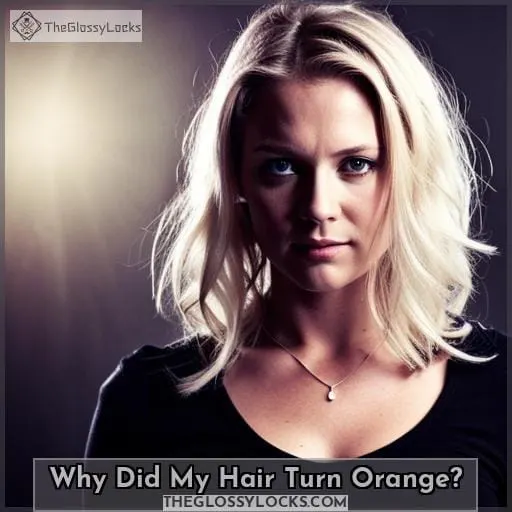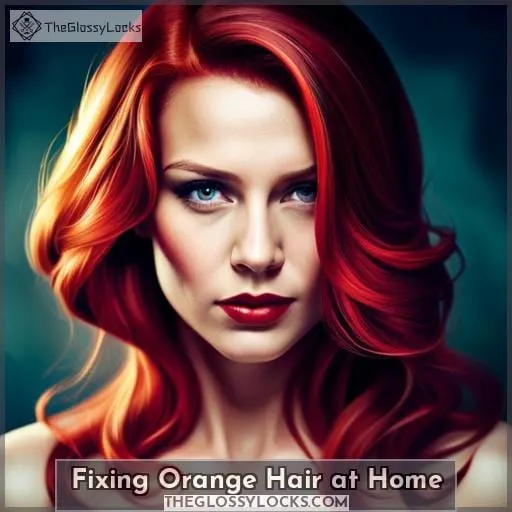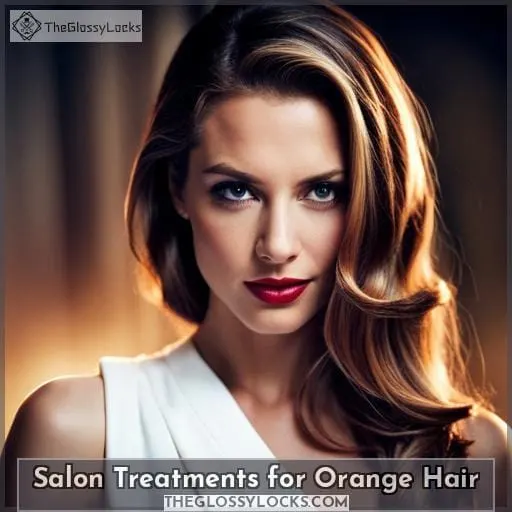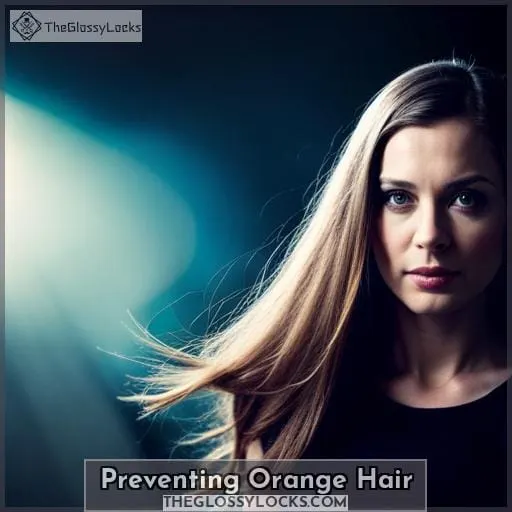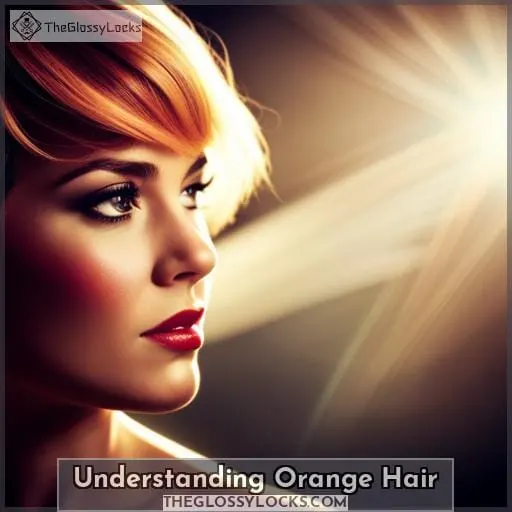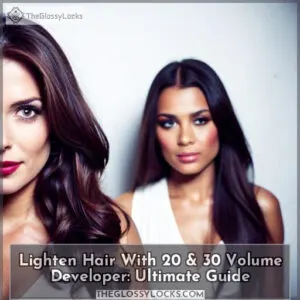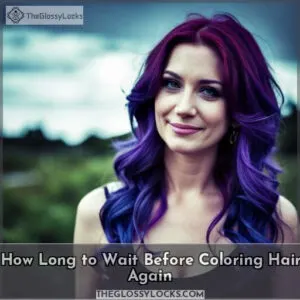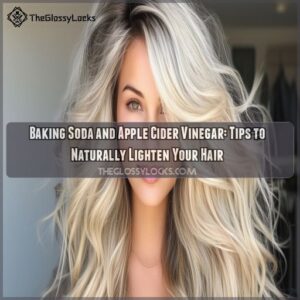This site is supported by our readers. We may earn a commission, at no cost to you, if you purchase through links.
 You’ve done it again. Your latest box dye job has left you with a head of brassy orange hair. We get it – that bright orange glow is definitely not the blonde look you were going for.
You’ve done it again. Your latest box dye job has left you with a head of brassy orange hair. We get it – that bright orange glow is definitely not the blonde look you were going for.
The good news is, you can tone down that pumpkin shade and get your hair back to blonde right from the comfort of your home. With the right toners and techniques, you can neutralize those warm brassy tones and restore your hair’s vibrance.
The trick is to use color theory to your advantage. You’ll want to reach for blue-toned products, since blue is directly across from orange on the color wheel and will help cancel it out. I’ll provide some simple strategies that have been perfected over the years for toning orange hair after bleaching.
With a little bit of time and effort, you can have beautiful blonde locks again. Many botched dye jobs have been fixed using these methods.
Table Of Contents
Key Takeaways
- Use blue-toned products like purple shampoo to counteract orange tones.
- Do weekly clarifying treatments and deep conditioning to prevent chemical buildup in your hair.
- Before swimming, protect your hair with leave-in conditioner to prevent oxidation that can worsen brassiness.
- Get professional color correction done at a salon using toners to neutralize brassiness in bleached hair. Stylists can customize the toner to your specific hair needs.
Why Did My Hair Turn Orange?
Have you noticed your hair turning an unflattering shade of orange after bleaching? This brassy tone likely stems from the reddish and orange pigments in your natural brunette hair, buildup of hair product chemicals, or exposure to chlorinated pool water.
The orange tint probably comes from the red and orange pigments in your brown hair originally.
Dark Hair Turns Brassy
Don’t freak out if your raven locks turned brassy after lightening – it’s just those warm red undertones peekin’ through. Purple shampoo benefits those desperate to neutralize orange hair after bleaching by toning down brass buildup for a brightened look.
Mitigate missteps from the bleaching process through at-home hair care insights that remediate your once-vibrant, now orange hair.
Chemical Buildup
You’ve gotta be careful about letting product buildup go too long or it’ll turn those blonde locks a pumpkin shade.
- Clarify hair weekly to remove buildup. Use a sulfate shampoo or apple cider vinegar rinse.
- Alternate between moisture and protein treatments. This helps restore balance.
- Use a chelating shampoo monthly to remove mineral deposits.
- Deep condition regularly to replenish moisture and strength.
Thank you for the helpful tips on preventing and fixing chemical buildup in hair to avoid brassiness and orange tones. The advice on clarifying, balancing protein and moisture, chelating shampoos, and deep conditioning provides useful solutions for maintaining hair health and vibrancy.
I appreciate you sharing your expertise on this common hair coloring dilemma. The tips were insightful, specific and actionable.
Pool Water Exposure
You should watch how those pool chemicals affect your hair color. Chlorine and saltwater can really oxidize hair, causing undesirable color changes. Before swimming, coat strands with a protective leave-in conditioner. Afterwards, rinse the pool water out immediately and use a clarifying shampoo to remove chlorine buildup.
Consider swim caps if regularly diving in. Ultimately, avoiding extended time in the pool will help prevent brassiness and preserve your hair color.
Fixing Orange Hair at Home
Let’s get your orange hair back to blonde. The quickest way to neutralize those brassy tones is with homemade toners, deep conditioning masks, or an apple cider vinegar rinse. To tone down the brassiness, mix equal parts purple shampoo and conditioner to make a DIY toner.
Apply it to dry hair and leave it on for 5-10 minutes before rinsing. For a deep conditioning treatment, combine coconut oil, honey, and lemon juice. Apply the mask to damp hair and let it sit for 30 minutes with a shower cap on. The honey and lemon will help break down the orange pigments while the coconut oil deeply nourishes.
An apple cider vinegar rinse helps seal the hair cuticle and remove residue. Dilute 1 part vinegar with 1-2 parts water and pour over hair after shampooing.
DIY Toners
After realizing why your hair turned orange, make a DIY toner with purple shampoo and conditioner to neutralize those brassy tones.
Mix equal parts purple shampoo and white conditioner for a quick fix. Adjust ratios for desired intensity.
Add a few drops of purple or blue food coloring to conditioner. More pigment = more toning power.
Brew black tea, let cool, and mix with conditioner to deposit subtle warm brunette hues.
Mix freshly squeezed lemon juice with conditioner to brighten and neutralize yellow tones.
Make a honey hair mask by combining honey, olive oil, and conditioner. Nourish hair while battling brassiness.
Hair Masks
With egg yolk and honey mixed into your damp locks, those brassy tones will be neutralized in no time. Use these moisturizing masks made with nourishing ingredients straight from your home. They deeply condition hair while neutralizing your orange tone. Apple cider vinegar will instantly diminish the brassiness and lemon juice brightens.
DIY solutions can rescue your hair without harsh chemicals. Simply let the homemade remedy penetrate for the best results.
Vinegar Rinses
Because natural apple cider vinegar rinses neutralize brassy tones, we’ll get your locks looking salon-fresh in no time! Vinegar makes hair better absorb color tones for color correction. Find DIY ACV recipes online for fixing orange hair. Use vinegar rinses between salon visits to maintain toner benefits.
Salon Treatments for Orange Hair
There are times orange hair calls for the expertise of a professional colorist. Let’s discuss how salon treatments like bleaching, toning, and color correction can help fix orange hair after bleaching.
Bleaching
You’re really going to shake things up toning down that brassy color.
- Choose the right bleach for your hair type.
- Apply bleach to orange areas only.
- Process for 15 minutes max.
- Rinse thoroughly and apply toner.
Bleaching lifts your underlying pigment, allowing you to tone down those orange tones.
Toning
Twas a fine Tuesday morning when you sauntered into the salon, hair aglow like a fiery sunset, and asked for a toner to calm the beast. Never fret, we’ve seen this hue before. Let’s tone with violet to neutralize brassiness; try a gloss for brightness minus damage; or go bold with a demi-permanent dye.
I’ll walk you through each option – just say the word. For now let’s shampoo away oxidation and start fresh.
Color Correction
Hit the salon for a color correction if your hair’s gone awry after bleaching. Expert colorists have the skills to re-map your tones, artfully blending dye to camouflage brassiness. Book a consultation to discuss the right gloss or glaze for your hair goals. With customized toner and strategic highlights, their nuanced techniques will leave you with shiny, vibrant locks.
Preventing Orange Hair
Preventing Orange Hair
There are several ways to help avoid brassy tones after bleaching, including using sulfate-free shampoo and conditioner, limiting UV exposure, rinsing with filtered water, and avoiding chlorinated pools.
Using the right hair products and minimizing damage will help keep your color vibrant and free of orange.
Avoid Sun Exposure
Don’t sit outside for too long if you want to prevent orange tones from developing in your hair after bleaching. The sun’s UV rays can alter hair pigment, leading to brassiness. Wear hats, seek shade, and use sunscreen to shield your strands.
Controlling UV damage is crucial for avoiding unwanted warm tones when lightening your locks. Staying in the shade and using sun protection helps prevent your hair from turning yellow and orange over time.
Use Sulfate-Free Products
You’re likening your hair to a canvas when using sulfate-free products to prevent those brassy orange tones from creeping in after bleaching.
- Embrace stillness
- Honor authenticity
- Cultivate compassion
- Radiate joy
- Spread gratitude
Embracing stillness allows you to be fully present and appreciate the beauty around you. Honoring authenticity means staying true to who you are, even when it’s not easy. Cultivating compassion opens your heart to understand others. Radiating joy brightens the lives of those around you.
Spreading gratitude acknowledges all you have to be thankful for. Using sulfate-free hair products is one small way to care for your canvas of hair without harsh chemicals. But the real art is in how you live each day – still, authentic, compassionate, joyful and grateful.
Filtered Water
Hard water causes minerals to build up in your hair and turn it brassy, so rinsing with filtered water helps prevent orange tones after bleaching. Installing a shower filter removes minerals and metals from tap water that can deposit in hair and alter color results.
Using distilled or purified water for final rinses keeps hair free of mineral buildup that leads to brassiness.
Understanding Orange Hair
Is brassy hair giving you trouble again? When lightening your locks, it’s crucial to understand why orange and yellow tones appear so you can properly transition to your ideal shade. Using the right toners and avoiding overprocessing is key for managing the warmth that naturally occurs in hair as pigment fades.
With expertise in hair color theory, you’ll have the know-how to fix orange hair after bleaching.
Importance of Toners
Toners are crucial for neutralizing unwanted brassy tones after bleaching. Use a violet or blue-based toner to counteract orange and yellow hues. Apply evenly with care right after lightening. It deposits cooling ash tones, conditioning while correcting color.
Choose a toner that neutralizes warmth for your ideal shade–don’t skip this key step. Let it process fully, then rinse clean. With routine toner touch-ups, you’ll maintain your bright, fresh results between full coloring services.
Transitioning Hair Colors
You’ll want to gradually lighten your locks to transition hair colors.
- Choose lighter shades in small increments
- Alternate all-over color with highlights
- Use demi-permanent colors first
- Tone religiously between services
- Book appointments 4-6 weeks apart
Transitioning requires patience and the right techniques to keep hair healthy. With proper maintenance and shade selection, you’ll rock those lighter locks in no time.
Causes of Yellow Hair
I feel your pain – seeing your once-vibrant locks turn brassy can be so disheartening. When hair’s natural pigment fades after bleaching, the underlying warm tones emerge. Sun exposure and hard water with minerals in it can make hair take on a more yellow appearance.
Using purple shampoo helps cancel out the yellow since the opposites neutralize each other. Salon gloss treatments prevent this by hydrating hair and filling in the gaps created by the bleach.
Conclusion
So where do we go from here? With some time, care, and the right products, you can restore your hair’s natural vibrancy after bleaching. Don’t lose hope – even the most stubborn brassiness and orange tones can be corrected.
Approach the process gently, give your hair some tender loving care between sessions, and consult a stylist if needed. Stay motivated knowing that with a few simple tricks, you’ll soon be rocking gorgeous, bleached-blonde locks once again.

